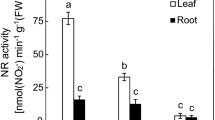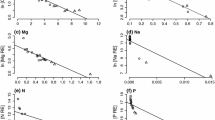Abstract
Tree seedlings that colonize large treefall gaps are generally shade-intolerant species with high potential relative growth rates. Nutrient availability may be significantly elevated in disturbance-induced gaps, however, little is known about the role of differences in nutrient uptake capacities of different species in structuring the community response to gap openings in eastern North American deciduous forests. Seven tree species were grown from seed under both a high and a low nutrient regime, and uptake kinetics of phosphate, ammonium, and nitrate were studied. Yellow birch, a species with intermediate shade tolerance and relative growth rate, had the highest maximum rates of uptake of all ions, while tulip tree, a gap-colonizing species with high relative growth rate, had the lowest rate of phosphate uptake and intermediate rates of ammonium and nitrate uptake. Beech and hickory, which have low relative growth rates and are not gap-colonizing species, had intermediate levels of nutrient uptake. There was no evidence that species with the highest maximum uptake rates measured at high supply concentrations had relatively low uptake at low nutrient supply concentrations. Although birch increased phosphate absorption capacity when grown under a low nutrient regime, this pattern did not hold for nitrate or ammonium uptake, and other species showed no change in nutrient uptake capacity according to nutrient growth regime. Clearly, factors other than nutrient absorption capacity, such as nutrient use efficiency or allocation to root vs. shoot biomass, underlie differences in species' capacities to colonize and maintain a high relative growth rate in canopy gaps.
Similar content being viewed by others
References
Atwell B J, Veerkamp M T, Stuiver C E E and Kuiper P J C 1980 The uptake of phosphate by Carex species from oligotropic to eutrophic swamp habitats. Physiol. Plant. 49, 487–494.
Baldwin I T and Schultz J C 1988 Phylogeny and the patterns of leaf phenolics in gap- and forest-adapted Piper and Miconia understory shrubs. Oecologia 75, 105–109.
Bazzaz F A 1979 The physiological ecology of plant succession. Annu. Rev. Ecol. Syst. 10, 351–371.
Bradshaw A D M, Chadwick M J, Jowett D and Snaydon R W 1964 Experimental investigations into the mineral nutrition of several grass species: IV. Nitrogen level. J. Ecol. 52, 665–676.
Canham C D and Marks P L 1985 The response of woody plants to disturbance: patterns of establishment and growth. In The Ecology of Natural Disturbance and Patch Dynamics. Eds. S T APickett and P SWhite. pp 197–216. Academic Press, Orlando.
Chapin F SIII 1980 The mineral nutrition of wild plants. Annu. Rev. Ecol. Syst. 11, 232–260.
Chapin F SIII 1983 Adaptation of selected trees and grasses to low availability of phosphorus. Plant and Soil 72, 283–287.
Chapin F SIII 1987 Adaptations and physiological responses of wild plants to nutrient stress. In Genetic Aspects of Plant mineral Nutrition. Eds H WGabelman and B CLoughman. pp 15–25. Martinus Nijhoff, Dordrecht.
Chapin F SIII and HollemanD F 1974 Radioassay of 32P in intact plant roots using Cerenkov radiation detection. Int. J. Appl. Radiat. Isotopes 25, 568–570.
Chapin F SIII, Follett J M and O'Connor K F 1982 Growth, phosphate absorption, and phosphorus chemical fractions in two Chionocloa species. J. Ecol. 70, 305–321.
Chapin F SIII and Oechel W C 1983 Photosynthesis, respiration, and phosphate absorption by Carex aquatilis ecotypes along latitudinal and local environmental gradients. Ecology 64, 743–751.
Chapin F SIII, VanCleve K and Tryon P R 1986 Relationship of ion absorption to growth rate taiga trees. Oecologia 69, 238–242.
Chiba N and Hirose T 1993 Nitrogen acquisition and use in three perennials in the early stage of primary succession. Funct. Ecol. 7, 287–292.
Clarkson D T 1967 Phosphorus supply and growth rate in species of Agrostis L. J. Ecol. 55, 111–118.
Coley P D, Bryant J P and Chapin F SIII 1985 Resource availability and plant antiherbivore defense. Science 230, 895–899.
Dirr M A 1983 Manual of woody landscape plants: their identification, ornamental characteristics, culture, propagation and uses. Stipes Publishing Company, Champaign, Illinois.
Elberse W T and Berendse F 1993 A comparative study of the growth and morphology of eight grass species from habitats with different nutrient availabilities. Funct. Ecol. 7, 223–229.
Elias T S 1980 The complete trees of North America. Van Nostrand Reinhold, New York.
Epstein E, Schmid W E and Rains D W 1963 Significance and technique of short-term experiments on solute absorption by plant tissue. Plant Cell Physiol. 4, 79–84.
Fowells H A 1965 Silvics of forest trees of the United States. US Dept Agric, Agric Handbook No 271.
Grime J P and Hunt R 1975 Relative growth rate: its range and adaptive significance in a local flora. J. Ecol. 63, 393–422.
Harrison A F and Helliwell D R 1979 A bioassay for comparing phosphorus availability in soils. J. Appl. Ecol. 16, 497–505.
Hull J C and Mooney H A 1990 Effects of nitrogen on photosynthesis and growth rate of four California annual grasses. Acta Oecol. 11, 453–468.
Koch G W, Bloom A J and Chapin F SIII 1991 Ammonium and nitrate as nitrogen sources in two Eriophorum species. Oecologia 88, 570–573.
Lambers H and Dijkstra P 1987 A physiological analysis of genotypic variation in relative growth rate: can growth rate confer an ecological advantage? In Disturbance in Grasslands. Eds. JvanAndel, J PBakker and R WSnaydon. Junk, Dordrecht.
Logan K T and Krotkov G 1968 Adaptations of the photosynthetic mechanism of sugar maple (Acer saccharum) seedlings grown in various light intensities. Physiol. Plant. 22, 104–116.
Matson P A and Boone R 1984 Nitrogen mineralization and natural disturbance: wave-form dieback of mountain hemlock in the Oregon Cascades. Ecology 65, 1511–1516.
Matson P A and Vitousek P M 1981 Nitrification potentials following clearcutting in the Hoosier National Forest, Indiana. Forest Sci. 27, 781–791.
McGraw J B and Chapin F SIII 1989 Competitive ability and adaptation to fertile and infertile soils in two Eriophorum species. Ecology 70, 736–749.
Nassery H 1970 Phosphate absorption by plants from habitats of different phosphate status. II. Absorption and incorporation of phosphate by intact plants. New Phytol. 69, 197–203.
Poorter H and Remkes C 1990 Leaf area ratio and net assimilation rate of 24 wild species differing in relative growth rate. Oecologia 83, 553–559.
Poorter H, Remkes C and Lambers H 1990 Carbon and nitrogen economy of 24 wild species differing in relative growth rate. Plant Physiol. 94, 621–627.
Rorison I H 1968 The response to phosphorus of some ecologically distinct plant species. I. Growth rates and phosphorus adsorption. New Phytol. 67, 913–923.
Runkle J R 1985 Disturbance regimes in temperate forests. In The Ecology of natural Disturbance and Patch Dynamics. Eds. S T APickett and P SWhite. Academic Press, Orlando.
Tilman D 1986 Nitrogen-limited growth in plants from different successional stages. Ecology 67, 555–563.
Tilman D and Cowan M L 1989 Growth of old field herbs on a nitrogen gradient. Funct. Ecol. 3, 425–438.
Van derWerf A, Visser A J, Schieving F and Lambers H 1993 Evidence for optimal partitioning of biomass and nitrogen at a range of nitrogen availabilities for a fast- and slow-growing species. Funct. Ecol. 7, 63–74.
Veerkamp M T and Kuiper P J C 1982 The effect of potassium on growth of Carex species from swamp habitats varying from oligotrophic to eutrophic and comparison of physiological reactions of Carex species to P stress and K stress. Physiol. Plant. 55, 242–246.
Vitousek P 1982 Nutrient cycling and nutrient use efficiency. Am. Nat. 119, 553–572.
Vitousek P M 1985 Community turnover and ecosystem nutrient dynamics. In The Ecology of natural Disturbance and Patch Dynamics. Eds. S T APickett and P SWhite. pp 325–333. Academic Press, Orlando.
Wilkinson L 1990 SYSTAT: The system for statistics. SYSTAT, Inc., Evanston, IL
White R E 1972 Studies on mineral ion absorption by plants. I. The absorption and utilization of phosphate by Stylosanthes humilis, Phaseolus atropurpureus and Desmodium intortum. Plant and Soil 36, 427–447.
Author information
Authors and Affiliations
Rights and permissions
About this article
Cite this article
Lajtha, K. Nutrient uptake in eastern deciduous tree seedlings. Plant Soil 160, 193–199 (1994). https://doi.org/10.1007/BF00010145
Received:
Accepted:
Issue Date:
DOI: https://doi.org/10.1007/BF00010145




